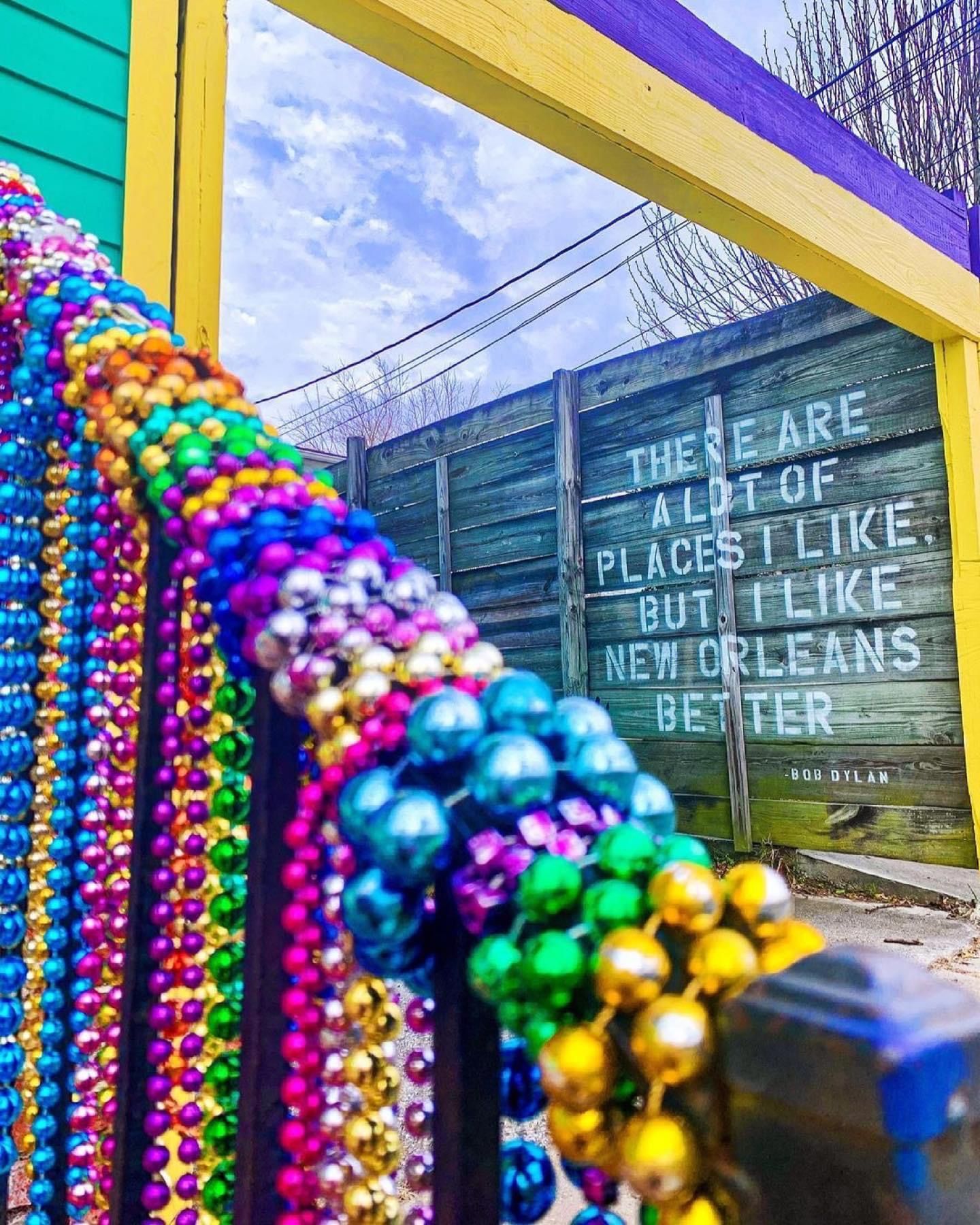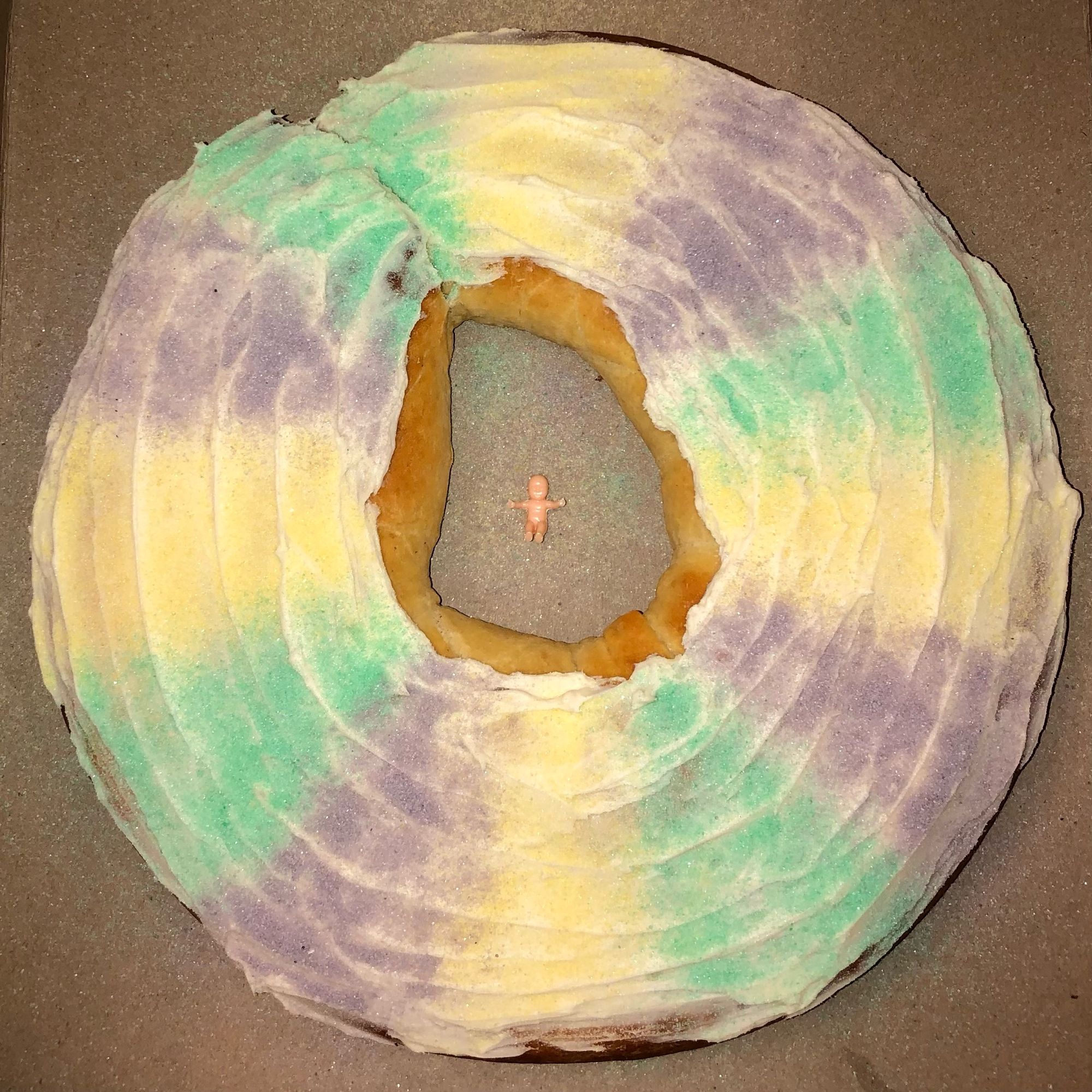King Cake & Mardi Gras in New Orleans

We are still in the early phase of Carnival season 2022 here in New Orleans. Mardi Gras season officially kicked off on January 6 (or January 2nd this year, thanks to our Catholic "moveable" feasts) and Ash Wednesday is not until March 2nd. This may be one of our lengthiest Mardi Gras seasons.
You may have never been to Mardi Gras in New Orleans. You may not even have pleasant thoughts when you think of Mardi Gras… Maybe the only thing you know about Mardi Gras is what you have seen on MTV and the news channels. For those folks, bad news is good news, so they like to portray the seedier side of things. But that’s not what Mardi Gras is all about. Believe it or not, Mardi Gras is Catholic through and through, and even today it is mainly a family celebration. I want to invite you into the festivities today by sharing with you a little bit about Mardi Gras and the delicious tradition of the King Cake.
A King Cake is essentially a large, round brioche bread/cake with a hole in the middle. It looks like a big donut. Traditionally, a small plastic baby is secretly inserted into the bottom of the cake before it is cut. Brioche is a simple yeast dough that is enriched with eggs and lots of butter. This simple dough yields an airy bread/cake that is soft and chewy.
King Cakes are always round or oval, which is a sign of a crown. It is a symbol of royalty.

Some King Cakes are the basic cinnamon brioche, others are filled with anything from cream cheese, raspberry or strawberry filling, or even a praline type of filling. Some King Cakes are topped with colored icing, others are topped with a white icing and different colored sugar sprinkles. The colors are always the colors of Mardi Gras: purple, green and gold.
But what does all of this mean? Why the reference to royalty? Why the specific colors? And for crying out loud, what’s up with the plastic baby inside the cake?
Excellent questions!
If you go back to the origins of the cake (and there are similar traditions in Mexico, Spain and France… and other places too), the basic symbolism comes from the Catholic celebration of Epiphany, also known as King’s Day. Epiphany, the culmination of the twelve days of Christmas, is traditionally celebrated January 6th. The celebration commemorates the scene in Luke’s Gospel of the Magi from the East (also thought of as wise men or kings) coming to pay homage to the new King… the King of Kings. The celebration of Epiphany officially closes the Christmas season.
But for those of us who live in south Louisiana, the celebration of Epiphany also opens something up… it kicks off for us Mardi Gras season… or Carnival season.
“Carnival” comes from the Latin “carne vale,” which literally means “good-bye meat.” For centuries, Catholics did not eat any meat or meat products during the entire season of Lent. So, on Carnival day, they celebrated by eating up any meat that they could find. In French (including Creole French down here in Louisiana), Carnival is called Mardi Gras, or Fat Tuesday. It’s always on a Tuesday because Lent always begins on Ash Wednesday.
Down here in south Louisiana, New Orleans in particular, we can come up with just about any reason to throw a party. We like to celebrate. So, we stretch out Carnival. For us, it is not just a day. It’s a season. Between January 6th and midnight Mardi Gras day we celebrate so that we can enter Lent “properly.”
Our modern celebration of the carnival season includes the baking of an estimated 750,000 King Cakes in the New Orleans metro area alone. During Carnival Season, King Cakes are bought or made and brought to offices to share with co-workers and to parties and family gatherings. The modern tradition dictates that whoever gets the baby has to provide the next King Cake. But where did that tradition start?
Well, in New Orleans at least, it began in 1871. The local newspaper, the Times-Picayune, ran this story back in September as it recalled the beginnings of some of our Mardi Gras traditions.
I should mention that this stretches back to the very beginnings of Mardi Gras in New Orleans. Some have noted that Mardi Gras actually started in Mobile, AL, not New Orleans. Which is true. Sorta.
Here’s what happened.
The first Carnival krewe in New Orleans was founded in 1857 by former members of the Cowbellian de Rakin Society out of Mobile. The Cowbellian de Rakin Society was founded in Mobile in 1830… 27 years before New Orleans’ first krewe. However, Mobile’s parades were held on New Year’s Eve, not Fat Tuesday. Mobile did not switch to Fat Tuesday until 1866, 9 years after Mardi Gras was rolling in New Orleans.
Very interesting.
So what about the colors? Why the purple, green and gold as the official colors of Mardi Gras?
Purple represents justice, green stands for faith, and gold stands for power. These colors were chosen by Rex (which means King) for his first parade in 1872. People must have liked the look of those colors together, because they stuck. They are now known as the Mardi Gras colors.
And the plastic baby?
Well, historically, the baby represents Jesus. Before plastic, folks would use a dried bean (like a fava bean) in the cake. Remember, the King Cake was originally part of the celebration of “King’s Day” or the Solemnity of the Epiphany, recalling the Magi’s search for the Baby Jesus. Today, getting the baby usually means that you are responsible for bringing the next King Cake to the next gathering.

Every year during Mardi Gras season, I used to be the one in the kitchen making the King Cakes, but the last couple of years, my oldest daughter Annabelle has taken the helm. This year, in fact, she is taking orders for our famous King Cakes, and business is booming. She's been making so many of them that she has discovered ways to improve the recipe. So it is with great joy that I am able to share with you Annabelle's new and improved recipe for our King Cake.
Enjoy!
UPDATED Catholic Foodie King Cake Recipe
Updated by Annabelle Young
INGREDIENTS
- 2 packets of active dry yeast (4 ½ teaspoons)
- ½ cup granulated sugar
- 2 sticks of butter, melted (I use 1 whole Kerrygold), about 110 F
- 1 cup of warm milk, about 110 F
- 5 large egg yolks, room temperature
- 2 teaspoons kosher salt
- 1 tsp freshly grated nutmeg
- Zest of one lemon
- 4 ½ cups of all-purpose flour (King Arthur)
- 1-2 teaspoons oil (light olive oil)
- 3 8oz blocks of cream cheese, room temperature
- 2 cups confectioner’s sugar
- 1 ½ sticks of regular butter
- 1 tsp vanilla extract
- 1-2 tablespoons milk
- 1 plastic king cake baby or pecan half
- White dusting sugar
- Purple, green, and yellow food coloring
METHOD
For The Dough
- Using a spoon, combine the yeast and the granulated sugar in the bowl of a stand mixer fitted with a dough hook. If you don’t have a stand mixer, don’t worry, you can do the same thing by hand in a large mixing bowl.
- Mix melted butter and warm milk in a bowl, making sure the temperature is about 110 F.
- Add the milk and butter mixture to the stand mixer and mix with a spoon for 1 minute.
- Add the egg yolks and mix for another minute.
- Add the salt, nutmeg, and lemon zest and mix until well-combined.
- Add the flour and beat with the electric mixer until everything is incorporated. Increase the speed to high and beat until the dough pulls away from the sides of the bowl and forms a ball (or starts to climb up the dough hook).
- Coat your hands and a large glass bowl with olive oil and remove the dough from the bowl. Using your hands, form the dough into a smooth ball.
- Place the dough in the bowl, rolling it around to coat it on all sides with oil. Tightly cover the bowl with plastic wrap and a clean kitchen towel and set aside in a warm, draft-free place (I use the microwave) for 2 hours minimum. It can rise for as long as 5 hours. You want the dough to double in size.
For The Filling
- In a large mixing bowl, combine the cream cheese and 1/2 cup of confectioner’s sugar. Blend using a fork or an electric mixer on medium speed. Scrape the sides and beat again. Set aside.
After The Dough Has Doubled In Size
- Turn the dough out onto a lightly floured surface. Using a rolling pin, roll it out into a large oval shape about 30 inches long and 6-8 inches wide.
- Take the cream cheese filling and spread it out lengthwise over the bottom half of the dough.
- Flip the top half of the dough over the filling and seal the edges with your fingers, pinching the dough together.
- Fold the pinched edges on the dough under so that the seam is not showing.
- Shape the dough into a cylinder and place it on a baking sheet (I use a round pizza stone) seam side toward the center. Shape it into a ring and pinch the ends together, doing your best so that there’s no visible seam.
- Cover the ring with a clean kitchen towel and set aside in a warm, draft-free place. Let the dough rise until doubled in size (about 45 minutes).
- Preheat oven to 350 F.
- Once the cake has doubled in size, remove the towel, and brush the surface of the cake with 2 tablespoons of milk.
- Place cake in oven and bake 25 to 30 minutes, until it is golden brown.
- Remove from the oven and place the cake on a wire rack so that it can cool completely.
- When it is completely cooled, insert the plastic baby, or pecan half, from the bottom of the cake.
For The Icing
- Beat the butter in a stand mixer fitted with the whisk attachment on medium-high speed until fluffy.
- Add the vanilla extract and 1 tablespoon of milk.
- Sift 1 ½ cups of confectioner’s sugar into the bowl and beat until smooth.
- Scrape the sides of the bowl and beat again. Add more milk or sugar if necessary.
- Once cooled, spread the icing on the cake using the back of a spoon or a spatula.
- Pour some dusting sugar into 3 separate plastic bags. Using food coloring, dye them purple, green, and yellow.
- Alternate the three colors until you have filled the whole cake.